Fish That Refuses to Undress
Let's start with a quiz. In one Kyushu dialect, people have characterized the flathead silverside (a type of fish) as とんころ, which means "to go to sleep without undressing." Why would they have called it that?
a. The fish is nocturnal.
b. Eating the fish works as an aphrodisiac.
c. Eating the fish makes people sleepy.
d. The fish is hard to scale.
I'll block the answer with a preview of the newest essay:
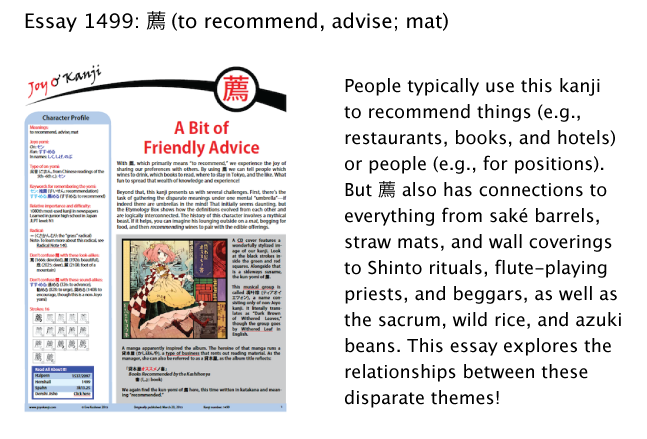
Ready for the answer?
d. People have described the fish as とんころ, says one site, because the flathead silverside is so hard to scale that it's as if the fish hates to be undressed!
Charming tidbits of this sort make my work worth doing and my life worth living. I'm not exaggerating!
I came upon that fun explanation while writing the forthcoming essay 2078 on 藤 (wisteria), a kanji that heads off the Japanese term for this fish:
藤五郎鰯 (とうごろういわし: flathead silverside, Hypoatherina valenciennei)
wisteria + 5 + male name suffix + sardine
The とんころ part evolved into とうごろう. As for the いわし (written in kanji with the non-Joyo 鰯) at the end of the yomi, that means "sardine." The kanji in 藤五郎鰯 are the kind of ateji in which the meanings don't matter, so this term has nothing to do with wisteria.
And yet if it weren't for wisteria, I wouldn't have found this term and had this experience. In fact, if not for wisteria, I would have missed out on the unending pleasure of writing essay 2078.
It deeply fulfilled me, particularly because the latter half explores 藤 in people's names, and it often felt right to present a round-up of past Joy o' Kanji content on the name at hand. For instance, I've written about the surname 伊藤 (いとう) in four essays and have an 伊藤 photo that I've never shared before. I pulled all that together into one caption under the new photo.
I did something similar with the name 斉藤 (さいとう) and then with 藤村 (とうそん), the pen name of famous novelist 島崎藤村 (しまざき とうそん). I didn't realize it until recently, but that author has made his way into three of my essays. His writer friend 北村透谷 (きたむら とうこく) also showed up in one. I have three photos related to 島崎藤村, including one that I took five years ago in Tokyo but never examined closely. Now I've discovered this: it's of a rock outside a school that both writers attended as kids, and it bears each of their names. What a thrill to have so many threads come together at once!
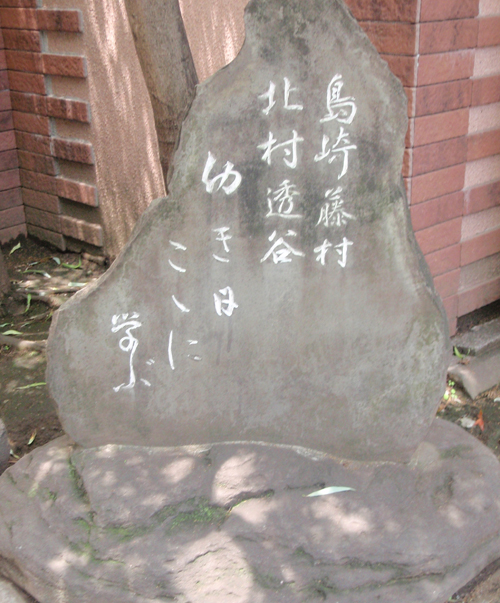
Photo Credit: Eve Kushner
I suppose I'm still in a round-up mood because I'd like to share some of the other gleanings from the 藤 essay, including the 伊藤 photo I mentioned. It contains these sorts of illustrations on a large sign:
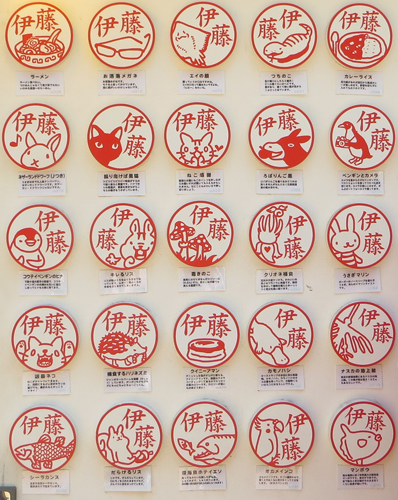
Photo Credit: Eve Kushner
You can't see it in the image shown here, but the sign includes this text:
オリジナルのゆるいイラストが入った認め印
Seals with original yurui illustrations in them
ゆるい (gentle); 入る (はいる: to be in); 認め印 (みとめいん: private seal; informal seal)
あなたの名前でつくります
We make them (the seals) with your name
名前 (なまえ: name); つくる (作る: to make)
As I learned, ゆるい is hard to translate. In general it means "loose," but when it comes to the popular mascot characters known as ゆるキャラ, the ゆる(い) has the nuance of "gentle, weak, laid-back, light-hearted, unimportant." That has nothing to do with wisteria or even with kanji, but delving into 藤 brought me to that new information, just as kanji study always does.
Here, for example, is a cultural factoid I learned while doing the essay: Tomitaro Makino is known as the father of Japanese botany because he named more than 2,500 plants and developed extensive classification systems. He also fathered 13 children. I wonder if he did so simply because he loved thinking of names!
Speaking of botany, the essay includes this word:
昇り藤 or 昇藤 or 上り藤 (のぼりふじ: (1) lupine; (2) a family crest inspired by the shape of the wisteria plant) climbing + wisteria
While working with this term, I quickly examined photos of lupine, a plant I hadn't known. And then today I had one of those experiences you have after learning a word and suddenly hearing it everywhere. I sat in a lovely courtyard at lunch, chatting with a new friend, and although I frequent that courtyard, I realized for the first time that it contains lupine. I saw that purple plant again on my run this evening. What joy to make a connection like that! And now that I've returned to the link, I've decided that I was dead wrong both times! Those plants weren't lupine at all! But it doesn't matter a bit to me because joy is joy, even when it comes from an error!
I exchanged notes with my proofreader about the second definition above, "a family crest inspired by the shape of the wisteria plant," and he showed me an image of that crest. This was an exciting bit of serendipity because essay 2078 had also prompted us to discuss another crest, one included in the following photo:
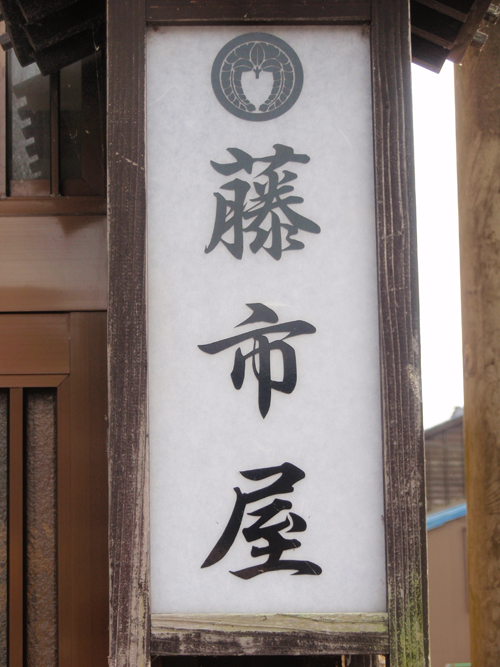
Photo Credit: Eve Kushner
It's easy enough to identify the kanji (藤市屋) here but hard to know how to read them (probably as ふじいちや) or exactly what they mean here. This uncertainty might have been a reason to cut the photo from the essay, but my proofreader saw something valuable and, to me, quite unexpected in this image. He said the symbol at the top is a 藤紋 (ふじもん), the family crest of the Fujiwara (藤原, ふじわら) clan! I had just written at length about the clan in the essay, tracing their influence over centuries, so for him to connect that information with a symbol in a photo that I took five years ago on Sado Island (northwest of Honshu) ... Well, I don't even know how to finish that sentence! Just tickle me purple with the thrill of wisteria and all that it brings!
I must say that I have a new appreciation for wisteria. This week I've come to adore its clusters of softly purple flowers and their heavenly fragrance. Right now in Berkeley, wisteria is fully in bloom, dangling from trellises, archways, rooftops, and eaves at every turn. When I venture outside, I see it as I've never seen it before and feel deliriously happy, rubbing the flowers to bring forth the scent and inhaling it as if my body could run on its perfume alone.
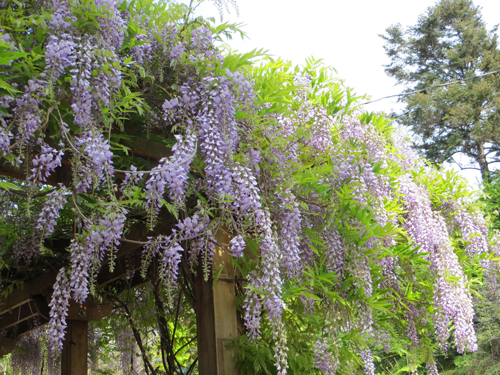
Photo Credit: Eve Kushner
Every wisteria blossom reminds me of how I've loved my work lately and how lucky I am to have such exhilarating experiences with both kanji and the natural world.
By the way, I gleaned so many tidbits from the wisteria essay that I might finish presenting them in next week's JOK Notebook—unless something else catches my fancy! In the meantime, have a great weekend! Enjoy the equinox!

Comments